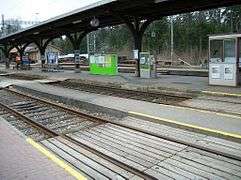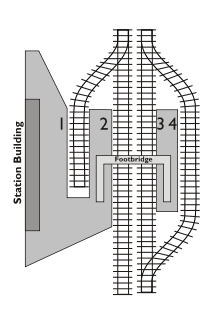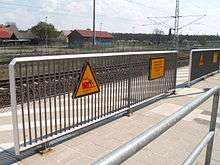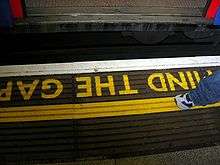Railway platform

A railway platform is a section of pathway, alongside rail tracks at a railway station, metro station or tram stop, at which passengers may board or alight from trains or trams. Almost all rail stations have some form of platform, with larger stations having multiple platforms. The term "platform" has also gained usage as a verb among some rail conductors, as in, "The first two cars will not platform at [station]".
The term "railway platform" can also mean any type of freight platform beside a rail siding for loading/unloading freight to/from rail cars.
Characteristics
The most basic form of platform consists of an area at the same level as the track, usually resulting in a fairly large height difference between the platform and the train floor. This would often not be considered a true platform. The more traditional platform is elevated relative to the track but often lower than the train floor, although ideally they should be at the same level. Occasionally the platform is higher than the train floor, where a train with a low floor serves a station built for trains with a high floor, for example at the Dutch stations of the DB Regionalbahn Westfalen (see Enschede). On the London Underground some stations are served by both District line and Piccadilly line trains, and the Piccadilly trains have lower floors.
A tram stop is often in the middle of the street; usually it has as a platform a refuge area of a similar height to that of the sidewalk (e.g. 100 mm (3.9 in)), and sometimes has no platform. The latter requires extra care by passengers and other traffic to avoid accidents. Both types of tram stops can be seen in the tram networks of Melbourne and Toronto. Sometimes a tram stop is served by ordinary trams with rather low floors and metro-like light rail vehicles with higher floors, and the tram stop has a dual-height platform, as in Amstelveen, Netherlands. A train station may be served by heavy-rail and light-rail vehicles with lower floors and have a dual- height platform, as on the RijnGouweLijn in the Netherlands.
Types of platform

Platform types include the bay platform, side platform (also called through platform), split platform and island platform. A bay platform is one at which the track terminates, i.e. a dead-end or siding. Trains serving a bay platform must reverse in or out. A side platform is the more usual type, alongside tracks where the train arrives from one end and leaves towards the other. An island platform has through platforms on both sides; it may be indented on one or both ends, with bay platforms. To reach an island platform there may be a bridge, a tunnel, or a level crossing. The climb up to the bridge or down to the tunnel may use stairs, ramps, escalators, lifts, or a combination of the above.
Identification
Most stations have their platforms numbered consecutively from 1; a few stations, including Cardiff Central, Haymarket, King's Cross, Stockport, and Gravesend (in the UK); Uppsala, (Sweden); and Lidcombe, Sydney (Australia), start from 0. Some, such as London Waterloo East, use letters instead of numbers (this is to distinguish the platforms from numbered ones in the adjoining Waterloo main-line station for staff who work at both stations); some, such as Paris-Gare de Lyon, use letters for one group of platforms but numbers for the other.
Usually platform numbering is a numbering of the boarding areas in the station (hence one island platform, for example, may have several numbered platforms). In some cases, tracks used only for through traffic without platform access also have a number. In North America, reference is usually made to a "track" (e.g. "The train is arriving on Track 5"). The term "platform" is also used in the US, but a single island platform may have access to two "tracks".
Facilities
Some of the station facilities are often located on the platforms. Where the platforms are not adjacent to a station building, often some form of shelter or waiting room is provided, and employee cabins may also be present. The weather protection offered varies greatly, from little more than a roof with open sides, to a closed room with heating or air-conditioning. There may be benches, lighting, ticket counters, drinking fountains, shops, trash boxes, and static timetables or dynamic displays with information about the next train.
There are often loudspeakers as part of a public address (PA) system. The PA system is often used where dynamic timetables or electronic displays are not present. A variety of information is presented, including destinations and times (for all trains, or only the more important long-distance trains), delays, cancellations, platform changes, changes in routes and destinations, and supplementary fee or reservation requirements.
Safety
In high-speed rail, passing trains are a significant safety problem as the safe distance from the platform edge increases with the speed of the passing train. Several countries have laws that prohibit trains passing platforms above certain speeds, usually 200 kilometres per hour (120 mph). For stations on high-speed lines, this leaves two alternatives unless all trains stop there: either a speed limit for passing trains, or the station has to be rebuilt to include tracks that completely bypass the platforms.

Some metro stations have platform screen doors between the platforms and the tracks. They provide more safety, and they allow the heating or air conditioning in the station to be separated from the ventilation in the tunnel, thus being more efficient and effective. They have been installed in most stations of the Singapore MRT and the Hong Kong MTR, and stations on the Jubilee Line Extension in London.
Platforms should be sloped upwards slightly towards the platform edge to prevent wheeled objects such as trolleys, prams and wheelchairs from rolling away and into the path of the train. Many platforms have a cavity underneath an overhanging edge so that people who may fall off the platform can seek shelter from incoming trains. A dangerous practice is sitting on the edge of the platform, which requires withdrawing the legs fast enough when a train arrives.
Markings

Platforms usually have some form of warnings or measures to keep passengers away from the tracks. The simplest measure is markings near the edge of the platform to demarcate the distance back that passengers should remain. Often a special tiled surface is used as well as a painted line, to help blind people using a walking aid, and help in preventing wheelchairs from rolling too near the platform edge.
In the US, Americans with Disabilities Act of 1990 regulations require a detectable warning strip 24 inches (61 cm) wide, consisting of truncated dome bumps in a visually-contrasting color, for the full length of the platform.[1]
Curvature
Ideally platforms should be straight or slightly convex, so that the guard can see the whole train when preparing to close the doors. Platforms that have great curvature have blind spots that create a safety hazard. Mirrors or closed-circuit cameras may be used in these cases to view the whole platform. Also passenger carriages are straight, so doors will not always open directly onto a curved platform – often a platform gap is present. Usually such platforms will have warning signs, possibly auditory, such as London Underground's famous phrase "Mind the gap".
There may be moveable gap filler sections within the platform, extending once the train has stopped and retracting after the doors have closed. The New York City Subway employs these at 14th Street – Union Square on the IRT Lexington Avenue Line and at Times Square on the 42nd Street Shuttle, and formerly at the South Ferry outer loop station on the IRT Broadway – Seventh Avenue Line.
In the UK, recent rules require new platforms to be straight.
Notable examples
Longest

The longest railway platforms are:
- Gorakhpur railway station, Uttar Pradesh, India:1,366.33 m (4,483 ft) (longest in the world)[2][3]
- Kollam Junction, Kerala, India:1,180.5 m (3,873 ft)[4][5][6][7][8]
- Kharagpur, West Bengal, India: 1,072.5 m (3,519 ft)[9][10]
- State Street subway, Chicago, Illinois, US: 1,067 m (3,501 ft) (longest in North America)
- Bilaspur railway station, Chhattisgarh, India: 802 m (2,631 ft)
- Cheriton Shuttle Terminal, Folkestone, United Kingdom: 791 m (2,595 ft) (longest in Europe)
- Jhansi, Uttar Pradesh, India: 770 m (2,526 ft)
- East Perth railway station, Perth, Western Australia: 770 m (2,526 ft) (longest in Australia)
- Kalgoorlie railway station, Kalgoorlie, Western Australia: 760 m (2,493 ft)
- Sonepur railway station, Sonepur, Bihar, India: 738 m (2,421 ft)[11]
- Nabadwip Dham railway station, Nadia, West Bengal, India 720 m (2,362 ft)
- Flinders Street Station, Melbourne, Victoria, Australia: 708 m (2,323 ft)[12]
- Port Pirie, South Australia: 701 m (2,300 ft)
- East Tsim Sha Tsui Station, Kowloon, Hong Kong: longest platform with platform screen doors: 300 m (984 ft)[13]
Sharpest curve
- 203 m (666 ft or 10 chains) Wollstonecraft railway station, Sydney (high level platforms)
See also
References
- ↑ 2010 ADA Standards, US Department of Justice, Sections 710.5, 810
- ↑ Gorakhpur gets world's largest railway platform - The Times of India
- ↑ Dinda, Archisman (October 9, 2013). "Uttar Pradesh gets world's longest railway platform". GulfNews.com. Retrieved 9 October 2013.
- ↑ "At a glance: Longest railway platforms in India". Railnewscenter. Retrieved 25 February 2015.
- ↑ "The Top 6 Longest Railway Platforms of India". Walk through India. Retrieved 25 February 2015.
- ↑ "West Bengal: tea plantations and other Raj-era relics".
- ↑ "Current Affairs: Longest Railway Platforms".
- ↑ "Malayala Manorama Daily(Kollam Edition 22/02/2015)". Retrieved 2015-02-22.
- ↑ "Trivia". IRFCA. Retrieved 2012-01-21.
- ↑ "Indian Railway Facts". iloveindia. Retrieved 2012-01-21.
- ↑
- ↑ Melbourne Crime Tours - Go West Tours Melbourne Archived April 3, 2012, at the Wayback Machine.
- ↑ (traditional Chinese)
External links
| Wikimedia Commons has media related to Train station platforms. |
| Wikidata has the property: number of platforms (P1103) (see uses) |
- "Emplacementstekeningen NS". www.sporenplan.nl (in Dutch). Schematic maps of all tracks, junctionsswitches and platforms in the Netherlands (point at an area and open detail map in a new window)
- "Train Station Page". www.railway-technical.com. Railway Technical Web Pages. Platforms. (UK-centric information)